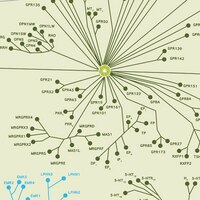Desensitization of the human motilin receptor by motilides.
Thielemans, Leen, et al.
J. Pharmacol. Exp. Ther., 313: 1397-405 (2005)
2004
Afficher le résumé
Tachyphylaxis may have contributed to the failure of the motilide ABT-229 [N-ethyl, N-methyl 4'' deoxy erythromycin (EM)-B enolether] in clinical trials. We compared the desensitizing potency of structurally related motilides [EM-A, EM-A enolether (ME4), N-ethyl, N-methyl EM-A (ME36), EM-B enolether (ME67), N-ethyl, N-methyl EM-A enolether (EM523), ABT-229 and 4'' deoxy EM-A enolether (KOS1326)] in a Chinese hamster ovary (CHO)-K1 cell line expressing the human motilin receptor (MTLR) and in rabbit duodenal segments. CHO-MTLR cells were preincubated with motilides prior to stimulation with motilin. The negative logarithm of the preincubation concentration reducing the maximal motilin-induced Ca(2+) flux to 50% was calculated (pDC(50)). Internalization was visualized in CHO-K1 cells containing an enhanced green fluorescent protein (EGFP)-tagged MTLR and quantified in binding experiments. The contractile response of repeated stimulations was measured in duodenal segments. In CHO-MTLR cells, the pDC(50) was ABT-229 (8.78) > motilin (7.77) > EM-A (4.78), different from their order of potency to induce Ca(2+) release (pEC(50)): motilin (9.39) >> ABT-229 (8.46) > EM-A (7.11). In cells with the EGFP-tagged MTLR, ABT-229 decreased membrane fluorescence by 25 +/- 2% compared with 16 +/- 2% for motilin and 8 +/- 2% for EM-A. Binding studies confirmed that EM-A did not induce MTLR internalization (residual binding 96 +/- 4% compared with motilin, 31 +/- 3% and ABT-229, 21 +/- 1%). Comparison of the pDC(50) and pEC(50) values of the other motilides ME4 (5.90; 8.08), ME67 (6.03; 8.12), ME36 (3.32; 6.62), EM-523 (6.02; 8.22), and KOS1326 (7.32; 8.14) suggested that the strong desensitizing properties of ABT-229 are mostly related to the removal of the 4''-OH of the cladinose sugar. The decline of the contractile response in duodenal segments correlated with the pDC(50). The ability to desensitize and internalize the MTLR is not only determined by potency. This may be an important criterion for the development of a clinically useful compound. | 15764739
 |
Receptor for motilin identified in the human gastrointestinal system.
Feighner, S D, et al.
Science, 284: 2184-8 (1999)
1998
Afficher le résumé
Motilin is a 22-amino acid peptide hormone expressed throughout the gastrointestinal (GI) tract of humans and other species. It affects gastric motility by stimulating interdigestive antrum and duodenal contractions. A heterotrimeric guanosine triphosphate-binding protein (G protein)-coupled receptor for motilin was isolated from human stomach, and its amino acid sequence was found to be 52 percent identical to the human receptor for growth hormone secretagogues. The macrolide antibiotic erythromycin also interacted with the cloned motilin receptor, providing a molecular basis for its effects on the human GI tract. The motilin receptor is expressed in enteric neurons of the human duodenum and colon. Development of motilin receptor agonists and antagonists may be useful in the treatment of multiple disorders of GI motility. | 10381885
 |











